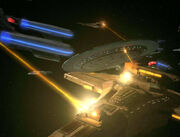Renegade54 (talk | contribs) m (formatting) |
No edit summary |
||
| Line 11: | Line 11: | ||
Sisko attempted to compensate by requesting the Sixth, Seventh, and Eighth [[Fighter Squadrons]] to regroup and offer their support, but the Dominion had jammed their communications signal by generating a rotating [[E-M pulse]]. ({{DS9|Sacrifice of Angels}}) |
Sisko attempted to compensate by requesting the Sixth, Seventh, and Eighth [[Fighter Squadrons]] to regroup and offer their support, but the Dominion had jammed their communications signal by generating a rotating [[E-M pulse]]. ({{DS9|Sacrifice of Angels}}) |
||
| + | |||
| + | {{bginfo|Analysis of the battle from {{e|Sacrifice of Angels}} showed no less than ten ''Galaxy''-class vessels in the combined [[Federation]] fleet during [[Operation Return]]. This would indicate that there were more than the initial six ''Galaxy''-class starships referenced in the ''Star Trek: The Next Generation Technical Manual''. The total of six ships stemmed from Roddenberry's assumption that Starfleet would not have constructed vessels of that large a size in substantial numbers. The ''Manual'' however also stated that an additional six space frames were constructed and laid up to be completed at a moment when circumstances so dictated. It can be conjectured that those circumstances arose after the first [[Borg]] incursion and that by the time the Dominion War began, all the remaining original ''Galaxies'' were operational. It could be theorized that a "Galaxy Wing" would be much like modern battle groups with lighter frigates/ships screening the main capital ship(s) (which would make sense due to the size and firepower of a ''Galaxy''-class starship).}} |
||
===See also=== |
===See also=== |
||
Revision as of 17:34, 10 October 2012

Galaxy Wing attacking a Galor-class Cardassian destroyer
Several Galaxy Wings, made up of Galaxy-class starships, were incorporated into the Starfleet fleet assembled by Benjamin Sisko to retake Deep Space 9. This larger fleet was itself composed from elements of the Second, Fifth, and Ninth Fleets.
These Galaxy units were responsible for engaging the larger targets in the combined Cardassian and Dominion fleet.
After several waves of attack fighters opened a hole in the Cardassian front lines, it was observed that several Galor-class destroyers were positioned in such a way that any vessel that would go through the hole would be trapped.
Viewing this potential trap as perhaps being the only opportunity to break open the Dominion fleet, Sisko ordered Galaxy Wing 9-1 and Galaxy Wing 9-3 to engage the Galor-class destroyers, and effectively "hold the hole open" while all remaining ships headed through.
Once the plan was initiated, Sisko observed that two ships from these wings that were supposed to be protecting the USS Defiant's starboard flank, the USS Magellan and USS Venture, were in "too tight."
Sisko attempted to compensate by requesting the Sixth, Seventh, and Eighth Fighter Squadrons to regroup and offer their support, but the Dominion had jammed their communications signal by generating a rotating E-M pulse. (DS9: "Sacrifice of Angels")
See also
- Destroyer Units
